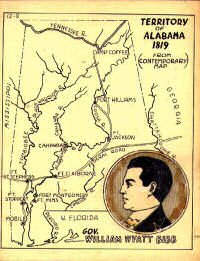 |
Territory of Alabama 1819
Alabama Dept. of Archives & History
( Look closer ) |
STATEHOOD:
Alabama's birth as a territory and road to statehood began with a series of treaties and occupations
involving, at various times, Great Britain, France, Spain and the United States of America.
With the establishment of the Mississippi Territory in 1798, present-day Alabama
began to take shape. The territory at first included land located approximately between the Chattahoochee
and Mississippi rivers and between the 31° and 32° 28' north latitudes; most of the
southern halves of Alabama and Mississippi. After the State of Georgia gave up its land claims in 1802,
the territory was expanded north by Congress (1804) to the 35th parallel. The territory now included all
of Alabama and Mississippi with the exception of the Mobile area, which was occupied by Spain.
In 1812, Congress added the Mobile area to the Mississippi Territory claiming that it was part
of the 1803 Louisiana Purchase from France. Spain disagreed, but in 1813, the United States forcefully
occupied the district with no resistance from Spain.
[ Mississippi Territory ]
Alabama was part of the Mississippi Territory until 1817 when the United States Congress divided the
territory into two parts. The western part, Mississippi, was granted statehood and the eastern part
became the
Alabama Territory.
William Wyatt Bibb was appointed as the Territorial Governor and St. Stephens was named as the
Territorial Capital.
Be it enacted by the Senate and House of Representatives of the United States of America, in
Congress assembled, That all that part of the Mississippi Territory which lies within the following
boundaries, to wit: Beginning at the point where the line of the thirty first degree of north Latitude
intersects the Perdido river, thence east to the Western boundary line of the State of Georgia, thence
along said line to the Southern boundary line to the State of Tennessee, thence West along said boundary
line to the Tennessee river, thence up the same to the mouth of Bear creek, thence by a direct line to
the north-west corner of Washington County, thence due South to the Gulph of Mexico, thence eastwardly
including all the islands within six leagues of the shore to the Perdido River, and thence up the same
to the beginning, shall, for the purpose of a temporary government, constitute a separate Territory, and
be called "Alabama".
Most of the first settlers in Alabama came on ships landing in Mobile bay. Towns initially grew along
the rivers north of Mobile but as settlers began to arrive from Tennessee, South Carolina and Georgia,
towns began to form in northern Alabama until, by 1819, Huntsville had become the largest settlement.
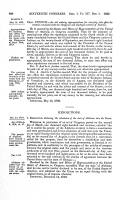 |
16th Session of Congress
Library of Congress
Alabama Becomes a State
( Look closer ) |
On January 19, 1818, the first legislature of the Alabama Territory, presided over by Governor
William Wyatt Bibb, met in the Douglas Hotel in St. Stephens.
On March 2, 1819, the nation's fifth President, James Monroe signed an
enabling
act paving the way for Alabama to enter the Union and on July 5th, 44 elected Alabamans met in
Huntsville to write a constitution and prepare for statehood. From the 5th through August 2, 1819, the
delegates hammered out Alabama's
1819 Constitution.
In September of the same year, Alabama's first constitutional election was held and
Territorial Governor William Wyatt Bibb was elected as Alabama's first State Governor. On October 25th,
the newly elected Alabama General Assembly met at Huntsville and elected William Rufus King and John W.
Walker as Alabama's first United States Senators.
On December 14, 1819, Alabama became the 22nd state to enter the Union.
|
| |
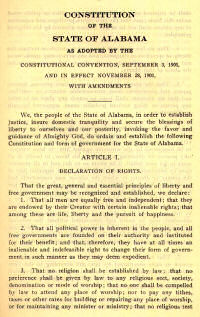 |
1901 Alabama Constitution
Alabama Dept. of Archives & History
( Look closer ) |
STATE CONSTITUTION:A constitution sets out the rules by which we play the game
of government. Like the rules for any other game, it limits the moves available to players. It describes
how the various players interact with each other, and who has more power in various situations.
From 1819 to 1901, Alabama has adopted and operated under six different constitutions, each
providing the state with an operating framework suited to the time of adoption.
The 1819
Constitution was created under the rules set out by the United States Congress in the
Enabling
Act of March 2, 1819. Among other things, this act set the guidelines by which Alabama could achieve statehood
and specified that delegate elections were to be held in May, 1819 for a Constitutional Convention to be
convened in Huntsville on
July 5 of the same year. This was the constitution that led to Alabama's statehood.
By 1861, relationships between slave-holding states and the others of the Union were stressed.
The Constitutional Convention of 1861, called the "Secession Convention," concerned itself
with Alabama's withdrawal from the Union of the United States. The
1861
Constitution of the Secession Convention was ratified by the convention on March 20. This constitution
was adopted as one that would provide governmental frameworks for Alabama after withdrawal from the Union.
The third Alabama Constitution, the
1865 Constitution,
was declared as Alabama reunited with the Union at the end of the Civil War. After a series of
proclamations, including an Amnesty Proclamation from President Andrew Johnson, a Constitutional
Convention convened at Montgomery and adopted a post-war constitution on September 12, 1865 intended to
provide for the state as it rejoined the Union.
As a result of the
1867
Reconstruction Acts of the United States Congress, the territories of the 11 "rebel states" were
divided into military districts and made subject to military authority. These acts were adopted by
Congress over vetoes by President Johnson "to provide for the more efficient government of the rebel
States." The second of these acts directed the states to "cause a registration to be made of the male
citizens of the United States, twenty-one years of age and upwards" and to collect oaths of loyalty to
the United States. It further instructed that an "election shall be held of delegates to a convention
for the purpose of establishing a constitution and civil government for such State loyal to the Union..."
The Reconstruction Acts led to the adoption of the
1868
Constitution.
On March 19, 1875, the Alabama General Assembly called for another Constitutional Convention
to be held "the first Monday in September, 1875 for the purpose taking into consideration the
constitution of this State, and revising and amending the same in the particulars wherein said
constitution appears to require amendment:" The
1875
Constitution became the first Alabama Constitution to be voted on and adopted by the citizens of the
state.
The
1901
Constitution, laid the framework that governs Alabama today. It was the sixth constitution adopted
by the state. Amendments to the 1901 Constitution have risen to over 740 making it the longest
constitution in the country.
The constitution provides ways to amend or adjust it as necessary. Changes, in the form of amendments,
may be initiated in the Alabama General Assembly or a Constitutional Convention may be called to enact
changes.
Constitutional amendments, when originating in the Legislature, must be approved by 3/5 of the
members of each house and then by a majority of the citizens of the state. A Constitutional Convention,
for the purposes of amending or altering the Constitution, may be called by a majority vote in each of
the houses of the legislature and must be approved by a majority of the citizens of the state. Acts
or resolutions regarding the Alabama Constitution that are approved in the legislature are not submitted
to the Governor of the state for his or her approval. In addition, a Constitutional Amendment may not
change the basis of representation in the legislature, which is based on population.
PREAMBLE:We, the people of the State of Alabama, in order to establish justice, insure domestic tranquility, and secure the blessings of liberty to ourselves and our posterity, invoking the favor and guidance of Almighty God, do ordain and establish the following Constitution and form of government for the State of Alabama:
[ ALABAMA CONSTITUTION ]
[ SIX CONSTITUTIONS OF ALABAMA ]
|
| |
|
STATE MOTTO:
"Audemus jura nostra defendere" is the
motto of the state of Alabama
with an intended English translation of "We Dare Maintain Our Rights."
Alabama's first motto, "Here We Rest," was approved by a Republican
legislature after the Civil War, during the period referred to as "Reconstruction." It was approved with
the adoption of a new state seal, replacing the one that had been used for 50 years. The previous state seal,
a carry-over of the Alabama Territorial Seal, depicted Alabama and its major rivers. The new seal displayed
a bald eagle perched on the shield of the United States Seal. In the eagle's beak was a banner that read
"Here We Rest."
Over 70 years later, in 1939, the original seal was restored as the Great Seal of Alabama. At the same time,
the state legislature adopted an Alabama Coat-of-Arms along with a new state motto: Audemus Jura Nostra
Defendere, translated as "We Dare Maintain Our Rights." The act to adopt an official Coat-of-Arms for the
State of Alabama was approved March 14, 1939, Act no. 140.
The selection of the motto is attributed to Marie Bankhead Owen, a Director of the Alabama Department
of Archives & History. In an article in the Birmingham News-Age Herald, dated April 23, 1939, she
stated that she was looking for "a phrase that would interpret the spirit of our peoples in a terse and
energetic sentence." She found her inspiration in a 1781 poem by Sir William Jones, An Ode in Imitation of
Alcaeus. In the poem the question is posed, "What constitutes a state?" Among the responses to this
question are the words
Men, who their duties know,
But know their rights, and, knowing, dare maintain,
Prevent the long-aim'd blow,
And crush the tyrant while they rend the chain:
An interesting bit of trivia about this motto is that it originated in English and was translated into Latin.
The motto was translated into Latin by Professor W. B. Saffold, of the University of Alabama.
[ AN ODE IN IMITATION OF ALCAEUS ]
|
| |
|
STATE GOVERNMENT:
As in the case of the federal government, Alabama's state government is
organized into three branches - executive, legislative, and judicial. The state government is a product of
three documents: the United States Constitution, the Alabama State Constitution, and laws of the state.
The Governor of Alabama is the chief executive officer of the state and is elected
by citizens for a four-year term and may serve for two consecutive terms. He or she is responsible for
appointing certain state officers, veto or approval of bills passed by the Legislature, granting pardons
and paroles, calling special sessions of the legislature, and commands the state militia. The Governor is
also responsible for the preparation of the state budget, and ensures that all laws are obeyed in the state.
The Alabama State Legislature is the lawmaking branch of the state government. The
Legislature has the authority to pass laws that people must obey. The Legislature is also responsible
for raising and distributing the money necessary to run the state government. Senators and Representatives
are elected by citizens to terms of four years.
The judicial branch
of the Alabama Government interprets the laws. The
Alabama Court System is made up of the Supreme Court, the highest court, and is presided over by
a chief justice and eight associate judges. There are two intermediate courts, the Court of Criminal
Appeals, with five judges and the Court of Civil Appeals with three judges. A series of Circuit Courts
serve as the major trial courts. There are 40 Circuit Courts in Alabama. All justices and judges, with
the exception of municipal court judges, are elected by the qualified voters of a respective court's
jurisdiction for six-year terms.
[ BRANCHES OF ALABAMA GOVERNMENT ]
[ OFFICE OF THE GOVERNOR ]
[ ALABAMA LEGISLATURE ]
[ ALABAMA JUDICIAL SYSTEM ]
[ GREAT SEAL OF ALABAMA ]
[ ALABAMA STATE FLAG ]
|
| |
 |
| Governor Kay Ivey |
GOVERNOR:Kay Ivey(Republican)
Kay Ellen Ivey was sworn in as the 54th Governor of Alabama on April 10, 2017 following the resignation of Robert Bentley. She is Alabama's second female governor.
Kay Ivey served as Lieutenant Governor of Alabama from 2011 to April 2017 and was the Alabama State Treasurer from 2003 to 2011.
Ivey was born in Camden, Alabama where she grew up working on her father's farm. She graduated from Auburn University in 1967 after which she worked as a high school teacher and bank officer.
[ GOVERNOR ]
[ FORMER STATE GOVERNORS ]
[ GOVERNOR'S MANSION ]
|
| |
|
CAPITOL or CAPITAL?
It should be simple, but we're never quite sure how we want to spell the word. Should it be
capitol or should it be capital? For our purposes, we've defined two simple rules...
- Spell the word with an "a" if you are referring to the city, within which the building resides, or you are referring to money.
- Spell the word with an "o" if you are referring to the building in which the legislature meets.
For those of you who think you've got it, it's time for a quiz.
[ POP QUIZ ]
|
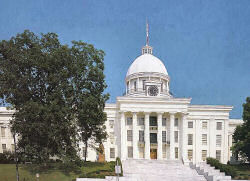 |
| Alabama State Capitol Building |
|
ALABAMA CAPITOL BUILDING:
Location:Montgomery
Date Erected:1850-1851, 1885, 1906, 1912, 1992
- The first capitol, built in Montgomery in 1847, burned down in 1849.
- The current capitol, built in the Greek Revival style, was constructed on the same site in 1850-1851.
- Jefferson Davis was sworn in as President of the Confederate States of America at the capitol on Feb. 18, 1861.
- A star on the capitol steps commemorates the Davis inauguration.
- A rear wing was added in 1885 and two side wings were added in 1906 and 1912.
- A rear extension, with portico, was added in 1992.
- The Alabama State Capitol was designated a National Historic Landmark in 1962.
|
|
|
[ STATEHOOD AND THE CAPITALS ]
[ HISTORY ]
[ MAP OF CAPITOL COMPLEX ]
[ HISTORY OF ALABAMA ]
[ VISITOR'S GUIDE ]
[ GUIDED TOURS ]
| | |
|
STATE REPRESENTATION:The Alabama Legislature, referred to as the General Assembly,
is composed of two bodies, called houses, like the United States Congress. The two parts are the Senate and
the House of Representatives. The Legislature is referred to as a bicameral body because it is made up of two
houses. The Latin roots of the word bicameral, "bi" and "cameral," mean two chambers or rooms. The Legislature
is responsible for making the laws in Alabama and for raising and distributing the money necessary to run the
state government.
[ ALABAMA LEGISLATURE ]
[ LEGISLATIVE PAGE PROGRAM ]
[ YMCA YOUTH LEGISLATURE ]
|
|
STATE REPRESENTATIVES:
Representatives in Alabama each represent
people in a specific area of the state. These areas are called house districts. There are currently 105 men
and women representing 105 house districts in the Alabama House of Representatives. 95 representatives are
Republicans and 52 are Democrats. Each representative serves for a period of four years in the House of
Representatives, after which he or she must run for re-election.
[ STATE REPRESENTATIVES ]
[ FIND YOUR LEGISLATORS BY ZIP CODE ]
[ HOUSE DISTRICTS ]
|
STATE SENATORS:
Senators in Alabama each represent people
in a specific area of the state. These areas are called senate districts. There are currently 35 men and
women representing 35 senate districts in the Alabama Senate. 10 representatives are Republicans and 25 are
Democrats. Each senator serves for a period of four years in the Senate, after which he or she must run for
re-election.
[ STATE SENATORS ]
[ FIND YOUR LEGISLATORS BY ZIP CODE ]
[ SENATE DISTRICTS (PDF Format) ]
|
|
| |
|
LEGISLATIVE PROCESS:The legislative branch of government is responsible for making and
maintaining laws within their jurisdiction. United States representatives and senators, federal legislators,
are responsible for laws at the national level and state legislators are responsible for laws at the state
level. A law begins as an idea that is introduced in the Alabama Legislature as a bill by one or more
legislators. The bill then goes through the legislative process to become a law. During this process the bill
may be changed. Not all bills become law.
[ HOW A BILL BECOMES LAW IN ALABAMA ]
[ LEGISLATIVE PROCESS ]
[ LEGISLATIVE TERMS ]
|
| |
| CURRENT LEGISLATION:
When the legislature is meeting, it is said to be "in session." The Alabama Legislature meets
each year on the first Tuesday in February, except (1) in the first year of the four-year term, (session will
begin on the first Tuesday in March) and (2) in the last year of a four-year term, (session will begin on the
second Tuesday in January). The length of this regular session is limited to 30 meeting days within a period
of 105 calendar days. There are usually two meeting or "legislative" days each week where all legislators gather
to meet. On other days, legislators may spend time in committee meetings or on other business. In a regular
session, bills may be enacted on any subject.
Special sessions of the Legislature may be called for by the Governor, who will specify a
list of subjects which he or she wishes considered. These sessions are limited to 12 legislative days
within a 30 calendar day span. In a special session, legislation should be enacted only on those subjects
which the Governor listed. Legislation not listed requires a tough two-thirds vote of each house to be enacted
during a special session.
The following link will allow you to look at bills that are currently going through the legislative process.
[ BROWSE LEGISLATION ]
|
| |
| STATUTES:
The following link will allow you to look at
Alabama's current laws, The Code of Alabama 1975.
[ CODE OF ALABAMA ]
|
| |
| COUNTIES:The United States Constitution does not define local government.
Instead, this function is left up to the states.
Counties are a local unit of government within a state. All but two of the states are divided into
counties. Alaska is divided into boroughs and census districts and Louisiana is divided into parishes where
governing responsibilities are similar to counties.
Traditionally, counties performed tasks mandated by the state, such as property assessment, property and vital
statistic record keeping, maintenance of rural roads, administration of local election and judicial functions,
and support of the poor. Today, counties may be responsible for these functions, more or less, but the
responsibilities of county governments vary from state to state.
| COUNTY TRIVIA:
- Alabama is divided into 67 counties
- The largest county, Baldwin County, has an area of 1,596 square miles.
- The smallest county, Etowah County, has an area of only 535 square miles.
- The most populated county, Jefferson County, has a population (2000 census) of 662,047.
- The least populated county, Green County, has a population (2000 census) of 9,974.
[ ABOUT COUNTY GOVERNMENT ]
[ ALABAMA COUNTIES ]
[ COUNTY GOVERNMENT MONTH ]
[ US CENSUS BUREAU ]
[ COUNTY MAPS ]
|
|
| |
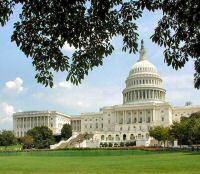 |
United States Capitol Building
Washington, DC |
U.S. CONGRESSIONAL DELEGATION:
The legislative branch of the United States government makes laws for our nation and raises and distributes
money to run the United States government. The most evident part of the legislative branch is the United
States Congress. Congress is divided into two parts, called houses. The two parts are the Senate and the House
of Representatives. Congress is referred to as a bicameral body because it is made up of two houses. The Latin
roots of the word bicameral, "bi" and "cameral," mean two chambers or rooms. Members of the Senate are called
Senators and members of the House of Representatives are called Representatives. Senators and representatives
serving in these two bodies are sometimes referred to as congressmen, or women, and sometimes as legislators
because their business is to legislate or make laws. The role of the legislative branch is defined in the
United States Constitution.
[ THE UNITED STATES CONSTITUTION ]
Each state elects people to represent them in the United States Congress in Washington, DC. The citizens of each
state elect two senators to represent them in the Senate. They also elect representatives to represent them in
the House of Representatives. The number of representatives each state sends to the House of Representatives
is not a specific number like the Senate, but is based on the population of the state. The people, that are
elected to represent the state's citizens in the United States Congress, are referred to as the congressional
delegation.
There are 100 senators in the U.S. Senate. Each is elected to a term, in the Senate, of six years. There are 435
representatives in the U.S. House of Representatives. Each is elected to a term, in the "House," of two
years.
The citizens of Alabama elect two people, like every other state, to represent them in the Senate and seven
people, based on Alabama's population, to represent them in the House of Representatives.
|
| |
|
broken links to us. We really appreciate it. |
Source: Alabama Department of Archives & History, November 11, 2004
Source: National Governor's Association, November 11, 2004
Source: United States Senate, November 11, 2004
Source: State of Alabama Web Site, November 12, 2004
Source: Office of the Governor of Alabama, November 12, 2004
Source: Alabama Legislature, November 12, 2004
Source: Alabama Judicial System Online, November 14, 2004
Source: United States House of Representatives, November 13, 2004
Source: The Political Graveyard, November 14, 2004
Source: State Names, Seals, Flags, and Symbols by Benjamin F. Shearer and Barbara S. Shearer, Copyright 2002
Source: State Names, Flags, Seals, Songs, Birds, Flowers, and Other Symbols by George Earlie Shankle, Ph.D., Copyright 1938
|
|
|
[ HOME
|| INTRO
|| SYMBOLS
|| ALMANAC
|| ECONOMY
|| GEOGRAPHY
|| STATE MAPS
|| PEOPLE
|| GOVERNMENT
]
[ FORUM
|| NEWS
|| COOL SCHOOLS
|| STATE QUIZ
|| BOOK STORE
|| MARKETPLACE
|| STATE LINKS
|| MUSEUMS
]
|| GUESTBOOK
|| CONTACT US
|| PRIVACY STATEMENT
] |
Site designed exclusively for NETSTATE.COM by NSTATE

NETSTATE.COM is a Trademark of NSTATE, LLC.
Copyright © 2004- by NSTATE, LLC. All rights reserved.
No copyright is claimed on non-original or licensed material.
Support NETSTATE
Top |
|



